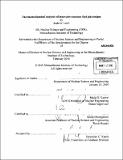Thermomechanical analysis of innovative nuclear fuel pin designs
Author(s)
Lerch Andrew (Andrew J.)
DownloadFull printable version (32.38Mb)
Other Contributors
Massachusetts Institute of Technology. Dept. of Nuclear Science and Engineering.
Advisor
Mujid S. Kazimi.
Terms of use
Metadata
Show full item recordAbstract
One way to increase the power of a nuclear reactor is to change the solid cylindrical fuel to Internally and Externally Cooled (I&EC) annular fuel, and adjust the flow and the core inlet coolant temperature. The switch to annular fuel allows for a 20% increase in core power density without changing the assembly size or the control rod placement. Such an approach is being considered for the Korean reactor OPR1400. The analysis of I&EC fuel with a modified version of FRAPCON-3.3 revealed that an uneven heat flux split between the outer and inner surfaces may develop which does not yield an optimal design. After optimization, it is found that excessive cladding oxidation on the inner channel of the hottest fuel pin may occur due to excessive internal heat flux, which is controlled by the gap conductance. As the gaps close asymmetrically, the MDNBR limit of 1.3 could also be violated. At the uprated power, control of the gap sizes is needed in order to satisfy the thermal-hydraulic requirements. One solution is to increase the flow rate to increase the MDNBR and to reduce the coolant temperature to decrease the cladding oxidation. Reduced-moderation Water Reactor (RMWR) is a boiling water reactor proposed to operate with mixed oxide fuel and, a harder neutron spectrum and higher local fuel burnup compared to the traditional Light Water Reactors. The fissile content of the fuel is concentrated in two pancake like regions in the core separated by a blanket (fertile-only) region. (cont.) The FRAPCON fuel performance code has been modified to assess the behavior of the RMWR fuel pins. Properties were modified to allow for a higher concentration of plutonium oxide. A new mechanistic model was adopted to simulate the fission gas release and swelling behavior of the fuel. The gas bubble swelling at the grain edges and grain faces were modeled separately. In addition, solid fission product swelling model was modified and the effect of axial migration of the volatile fission product behavior on fuel performance was also analyzed. Specifically, the cesium migrates axially based on the evaporation/condensation mechanism. Cesium precipitation at the fuel blanket interface and the resulting excessive swelling of the fuel pin at these locations could potentially be a major source of local stresses. Furthermore, as-fabricated porosity migration, central void formation, and hot-pressing of the fuel pellet were also modeled. Finally, axial variation of the material properties was allowed to represent the active fuel region and the blanket regions. The updated version of FRAPCON (called FRAPCON-EP) was checked against experiments then used to analyze the RMWR fuel behavior to optimize various parameters such the fuel pellet smear density, plenum height, and achievable peak burnup in order to achieve performance that could satisfy the NRC requirements for fuel pins.
Description
Thesis (S.M.)--Massachusetts Institute of Technology, Dept. of Nuclear Science and Engineering, 2010. Cataloged from PDF version of thesis. Includes bibliographical references (p. 152-154).
Date issued
2010Department
Massachusetts Institute of Technology. Department of Nuclear Science and EngineeringPublisher
Massachusetts Institute of Technology
Keywords
Nuclear Science and Engineering.